More homes mean more heat. Can new building codes help save metro Phoenix from disaster?
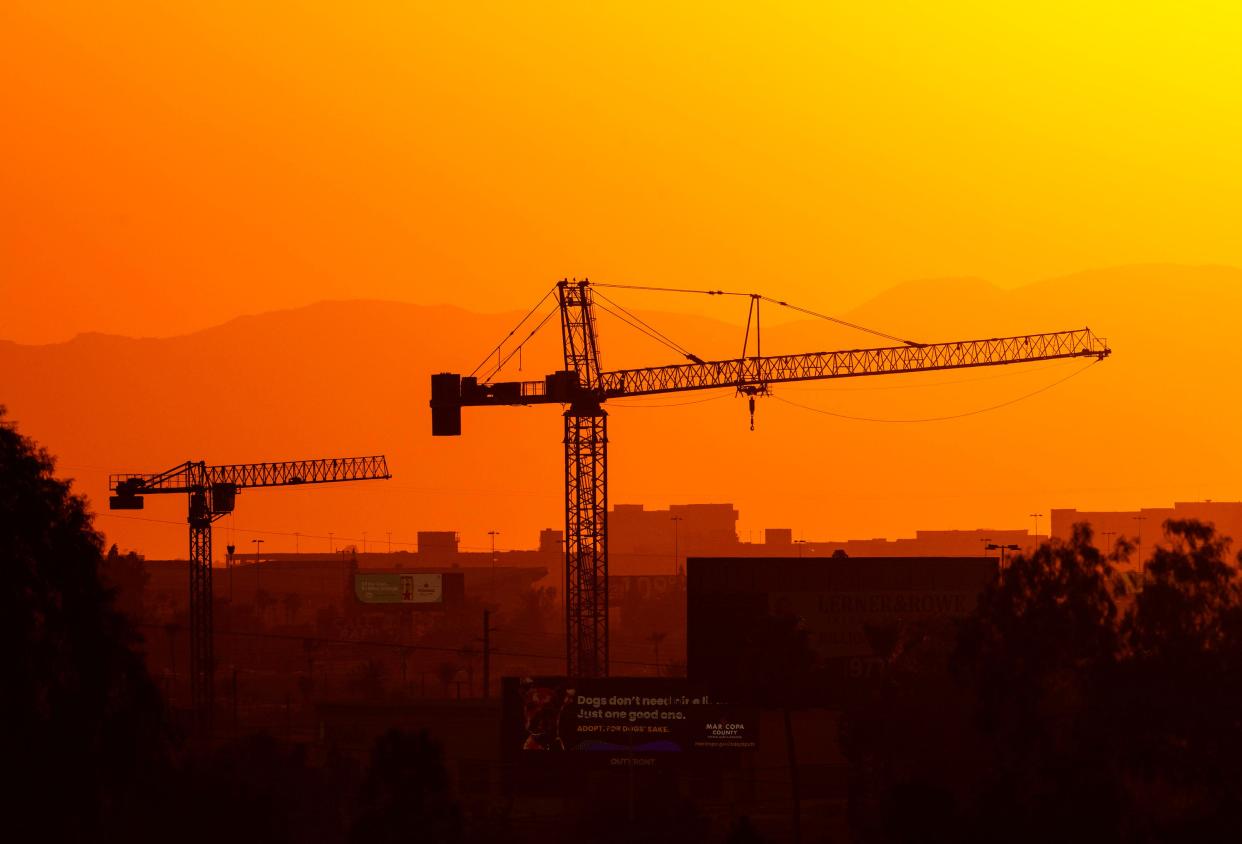
Arizona's heat and housing crisis:
Statewide | Metro Phoenix | Farmworker housing (coming soon) | Building on the reservation (coming soon) | Solutions (coming soon) | Map
Kathy Shows sits on bedding made of furniture pads laid out on the sidewalk at the corner of Jefferson and 12th Avenue near downtown Phoenix. At 11 p.m. on the 25th day of a record-breaking extreme heat wave, it's still 99 degrees outside after a high of 116. Concrete cools slowly after the sun goes down.
Every few minutes, the 63-year-old Shows pours water from a plastic bottle over her bare arms and legs and splashes some on her face to keep her cool. Her boyfriend, Fernando, who is recovering from liver surgery two months ago, sleeps shirtless next to her. But she has trouble resting in this heat.
Across an urban landscape increasingly reliant on air conditioning as temperatures rise, Shows and her boyfriend are two of nearly 10,000 people experiencing homelessness in Phoenix and Maricopa County as of January 2023, an uptick of 7% since 2022 and 72% since 2017. Experts say it’s likely an undercount.
Hundreds have set up camp — pitching tents and making shelters out of tarps, wooden pallets and cardboard — across a stretch of asphalt west of downtown Phoenix known as “The Zone,” near a shelter and other support services for the unhoused. Shows tried to get a bed in the air-conditioned shelter for the night, but she got in line too late and even the overflow spaces were full. So she’s sweating it out on the sidewalk a few blocks away.
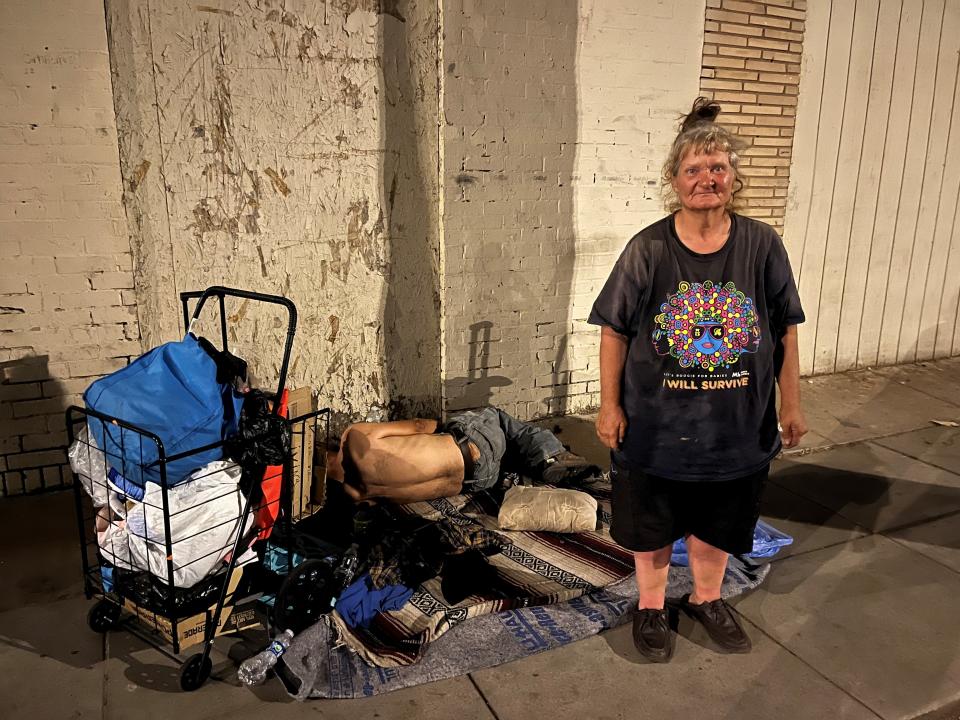
In the morning she’ll try again to find temporary work at the job agency. She’s had luck in the past, getting shifts clearing debris at luxury apartment construction sites along Van Buren Street, earning $15 per hour for a 6 a.m. to 2 p.m. shift. Two weeks ago she was making enough to pay the weekly rate at a motel where she and Fernando take shelter from extreme heat when they have the funds. Lately, her luck has run out.
“Once it’s nighttime, it’s not so bad,” Shows said, cracking open another disposable water bottle, pouring a small amount in her hand and carefully wetting her face. “At a certain time in the morning, it’s bad, it’s treacherous, it’s not so good. I get a piece of cardboard and I shelter myself behind the job agency when I can’t get work.”
With hardly a patch of shade or vegetation in sight, The Zone is one of the hottest areas in Arizona, due in part to what is known as the urban heat island effect, the result of man-made structures heating up faster in the sun and cooling down more slowly overnight compared to natural surfaces.
A recent analysis by the nonprofit organization Climate Central found that 1.3 million people live in areas of Phoenix that are, on average, now 8 degrees hotter due solely to urban development compared to an undeveloped landscape. That's on top of warming caused by climate change. The same is true for 408,000 people in certain regions of Tucson. Often the hottest neighborhoods are those with more low-income and Latino residents, due to differences in shade, construction materials and design compared with wealthier, whiter areas.
A flurry of residential construction projects, like the ones where Shows works debris cleanup, are contributing to urban warming across what is already America’s hottest big city. In 2020, rapid population growth made Phoenix the nation's fifth-largest city, then kept on going. These projects are badly needed to meet skyrocketing housing demands.
But as they go up, they make life for those not taken in under their roofs hotter and harder.
'The more you build the more you warm'
Arizonans like Shows embody the conflict between the state’s escalating housing crisis and its urgent climate crisis.
Maricopa County is the nation's hot spot for both temperatures and growth. In 2022, it gained more residents than any other U.S. county, according to a census report, and ranked fifth among metro regions for home building.
An earlier investigation by The Arizona Republic found that a majority of the construction does not match the type of housing that would best address either availability or the need to manage urban heat and climate change. Denser, multifamily units could boost affordable inventory faster while placing less strain on water and energy resources and adding less heat, but Maricopa County is building three times more sprawling, single-family homes.
Part of the problem is that there is no statewide approach to sustainable development. Some individual cities have taken steps toward greener building. But a new analysis by The Republic finds that much of this is symbolic, with meaningful progress often undermined by political pressure from special interest groups or even the cities themselves.
The result, in many cases, is worsening heat and homelessness.
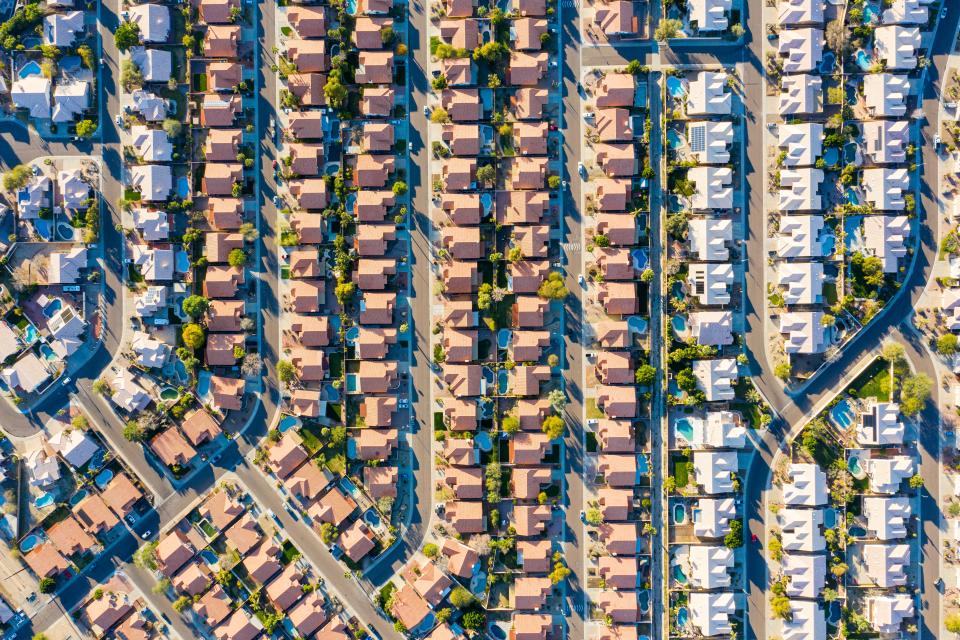
In 2020, Phoenix conducted a study of the city’s housing inventory and estimated an immediate need for 163,000 additional units. About 63,000 of those could be rented at market rate, the city concluded, but the other 100,000 — 61% of the total — would need to be subsidized to get people off the scalding streets or out of poorly insulated shelters and into more suitable homes. Of those, the city estimated 9,000 units would be needed for seniors, 5,000 for veterans, 9,000 for persons with disabilities and 1,451 for people experiencing homelessness — all groups of people research has shown are heavily affected by exposure to extreme heat.
But despite a breakneck construction pace, census records from 2010 and 2020 show it took a decade to add 172,000 apartments or homes across all of Maricopa County. Only 7,600 of those — just over 4% — were state-subsidized affordable units, according to data on funded projects from the Arizona Department of Housing.
Instead, much of the recent residential building has come in the form of golf-adjacent retirement homes that dot the desert with private pools, creating a landscape that, from a bird’s-eye view, resembles aquamarine spots on the desert floor, like the spots on the dusty hides of the jaguars that roamed this region before the bulldozers.
Meanwhile, as Phoenix was falling behind in the housing crisis with an average of one new unit for every five new residents between 2010 and 2020, the city’s average annual temperature rose by about 2 degrees Fahrenheit.
About half of warming in city centers over time can be attributed to the urban heat island effect, says Matt Georgescu, director of the Urban Climate Research Center at Arizona State University. The other half is due to climate change, caused by greenhouse gases that retain solar heat emitted into the atmosphere when fossil fuels are burned for energy.
Urban development, particularly sprawl, accelerates both — adding heat-absorbing surfaces such as roofs, parking lots and roads and emitting greenhouse gases through the manufacture and transportation of materials and additional energy use in new buildings.
“For a city like Phoenix, which 50 years ago was just a small dot on the map, the more you build the more you warm," Georgescu said.
In feeding the urban appetite to build, what and who is disposable?
People like Shows are most at risk from this warming, even on days when she also benefits from local construction by working cleanup shifts.
In 2022, 425 people died from heat-related illness in Maricopa County. Of those, 178 were unhoused and 260 were over the age of 50. That total has risen more than 2,000% since 2001 when the Maricopa County Department of Public Health reported 21 heat deaths, and medical examiners expect 2023 to break all previous records. Deaths occurring outdoors make up most of the increase, with the ZIP codes that include The Zone a common setting.
As heat becomes the most deadly natural disaster, more people are being evicted into it. During July 2023, when Phoenix logged the hottest month on record for any U.S. city, 7,000 renters faced eviction across Maricopa County, which is on track to hit 80,000 eviction filings this year. Single mothers, retirees and veterans are some of the most affected groups, according to housing advocates.
This record number of evictions since the recession comes as rent in metro Phoenix has shot up almost 80% between 2016 and 2021 while median income increased only 22%. Competition for limited units prompted some landlords to stop accepting housing vouchers meant to help low-income families. The Republic documented a resulting trend of newly homeless Arizonans living for free on public lands, sometimes in ways that increase the risk of wildfire.
Others try to hang on to their housing by cutting costs elsewhere. About 30% of heat mortality in Maricopa County occurs indoors where people lacked air conditioning or turned it off to save on electricity costs. A disproportionate number of these deaths occur in mobile homes, which make up 10% of housing in Arizona but just 6% nationwide. These structures offer little insulation from the heat but can be deemed ineligible for federal utility or weatherization assistance programs because of their condition, mobility or location, according to ASU geographer Patricia Solis.
“Sometimes they will have air conditioning and it's not working, sometimes they will have AC but not electricity, or they will have both AC and electricity but they just didn't turn it on because it costs too much,” Solis said. “We have heard people say they paid $400 a month in the summer, if you can believe that, per trailer.”
Despite these hazards, a warming, drying climate may actually spur an inflow of people to metro Phoenix. Matthew Hauer, a researcher at Florida State University, estimates that sea level rise will motivate an additional 100,000 Americans to leave increasingly flood-prone coastlines for the Phoenix-Mesa-Scottsdale area by 2100. In that time, scientists expect local temperatures to rise by up to 9.5 degrees and heat waves to become more frequent and intense.
It’s all part of a pattern of human migration to city centers. The latest report from the Intergovernmental Panel on Climate Change predicted that, by 2050, urban zones will have to make room for another 2.5 billion people due to global population growth and the waning appeal of agrarian lifestyles amid water shortages and heat-related crop failures.
With demands for more and better shelter from extreme temperatures pitted against a need to curb rising urban heat, experts say the Venn diagram of solutions largely comes down to how development happens.
“There’s this idea that cities are inherently bad things: They’re bad for the environment, they’re polluting and so forth. And it can be a problem if it’s not done well," said Chris Boone, dean of ASU’s College of Global Futures and an expert on urban sustainability. "But it’s not going to go in reverse. So how do we use an increasingly urban planet to our advantage?"
Paving paradise: Building disasters and rebuilding after disasters
If you’re in a window seat on a flight in or out of Sky Harbor International Airport in Phoenix, look down on the sun-drenched Salt River Valley.
Beyond the small cluster of high-rise buildings downtown, the scene is one of dusty roofs atop tan-colored houses that line crescent-shaped suburban streets as far as the eye can see. As new neighborhoods pop up, the desert is innervated by endless black roads.
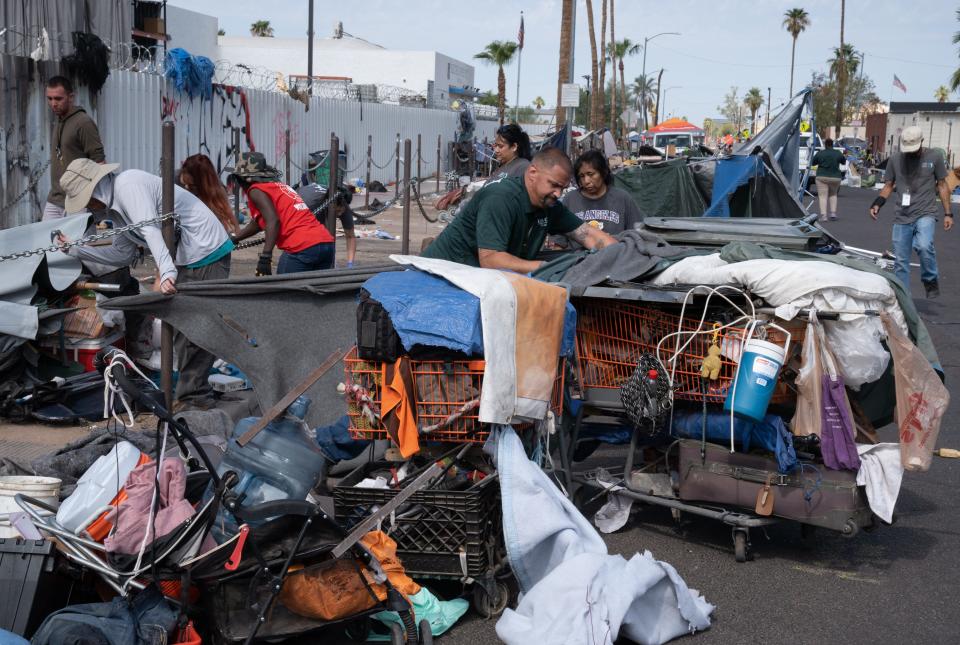
That much asphalt adds a lot of heat. One inventory of local land use found that, as of 2017, about 10% of surface area in metro Phoenix was dedicated to parking, with 4.3 spaces per vehicle and three per person, many of those along residential streets. The Federal Highway Administration reports that such surfaces can register midday temperatures of up to 176 degrees in Phoenix. Emergency rooms stay busy on hot summer days with patients who suffered contact burns from falling onto the pavement.
It’s the type of environment that makes the plot of Paolo Bacigalupi’s 2015 futuristic thriller "The Water Knife" seem plausible. Set in the dusty wasteland of an overextended Phoenix after the water wars, the rich hoard resources in high-security, self-sustaining apartment towers while the rest of society struggles to survive exposure to worsening heat and drought.
In reality, Phoenix Mayor Kate Gallego assured her constituents this summer that the city is not running out of water and is taking steps to manage heat. But recent news still smacks of a prelude to Bacigalupi’s tale.
This January, taps ran dry for 500 new luxury homes in the unincorporated community of Rio Verde Foothills north of Scottsdale. In May, under much duress, Arizona, Nevada and California finalized a joint plan to cut reliance on the strained Colorado River. And in June, a state groundwater model estimated that Arizona would fall 4% short of needed supplies in 100 years, prompting Gov. Katie Hobbs to impose a building moratorium in some outlying parts of the metro area.
Still, when international reports of the July 2023 heat wave cast doubts on metro Phoenix’s future habitability, local leaders stood their ground. The region can still build the cooler future envisioned by climate optimists, they insisted, while avoiding the future scripted by dystopian sci-fi novels.
“It appears that people are betting on Phoenix,” said David Hondula, director of the city’s Office of Heat Response and Mitigation, at a press conference about the July heat wave. “Growth here is happening at an incredible rate. If we're very aggressive in deploying heat mitigation strategies and global-scale emissions decelerate quite rapidly, it is possible in terms of air temperature, we have a Phoenix of the future that's cooler than the one we have today.”
But is it probable?
Disasters have historically pushed societies to reinvent how they are constructed, said Tim Lant, a mathematician and public health researcher at ASU. The bubonic plague that killed a third of the European population in the 14th century was largely an issue of housing, he said, and it changed the way we design urban sanitation systems. Similarly, the 1906 earthquake that ignited fires that burned down much of San Francisco led the city to rethink building codes, urban design and even the construction permitting process.
The latest report from the Intergovernmental Panel on Climate Change was optimistic about opportunities for urban heat mitigation if development proceeds in climate-smart ways. Technological advances in water conservation, for example, helped reduce total consumption over recent decades as populations grew, freeing up water for the maintenance of cooling greenery.
The Republic, with support from the Massachusetts Institute of Technology’s Environmental Solutions Initiative, conducted an independent review of local building codes and found examples of urban areas in Arizona taking steps in this direction.
Tempe is pushing a “build up, not out" policy by reducing parking requirements to allow for denser, multifamily housing development that would limit asphalt expansion while concentrating a growing population into walkable city centers. In Flagstaff and Tucson, ordinances for residential solar readiness facilitate the installation of electric stoves, heat pumps and other appliances powered by rooftop solar that can help slow atmospheric warming by cutting emissions. And Phoenix's heat office is pioneering initiatives to expand tree shade and cooling coatings for rooftops and pavement.
Amid aftershocks of a global pandemic, extreme heat, record drought and a destructive megafire regime, has metro Phoenix arrived at its disaster inflection point?
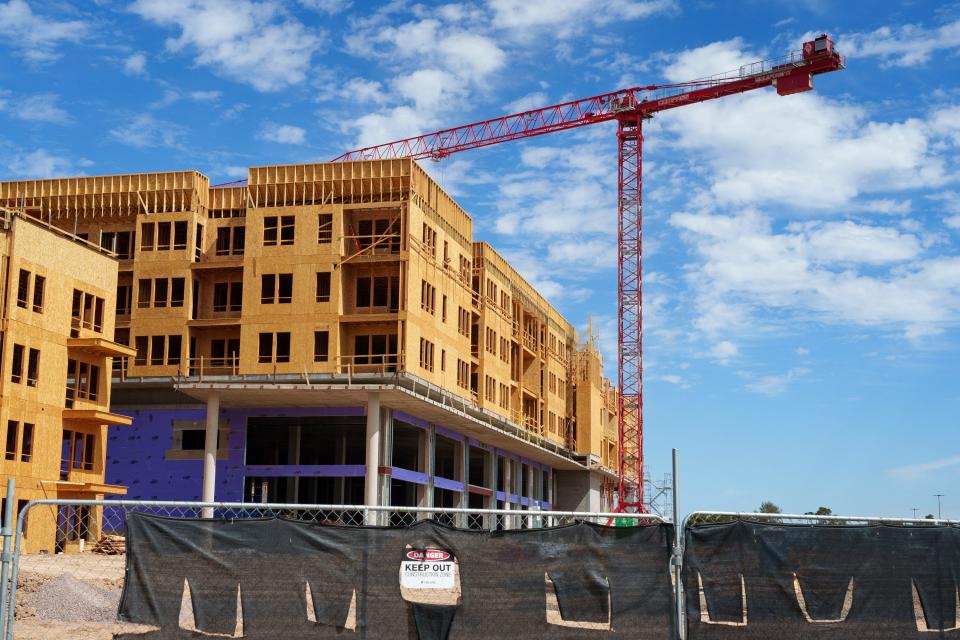
Decoding building practices
The Republic, with support from MIT, evaluated whether Maricopa County towns and cities are on a trajectory to meet housing needs while addressing the challenges of a warming, drying climate.
First, The Republic obtained building codes for all Maricopa County municipalities and several in other parts of the state for comparison. We reviewed these documents to identify major rules as well as significant amendments to either relax or tighten restrictions related to sustainability. We then screened codes for mention of a climate risk assessment (which no municipality specified), water conservation, energy efficiency, air quality standards, flood prevention and stormwater control, architectural or tree shade requirements, encouragement of construction with sustainable materials, wildfire precautions and natural habitat protections.
From there, The Republic assigned a “climate score” between 1 (minimum sustainability considerations) and 5 (maximum) to each municipality. Mandatory or voluntary adoption of the latest standards set by the International Code Council’s Energy Conservation Code, Green Construction Code, Wildland-Urban Interface Code or Solar Energy Provisions influenced the score, as did any extra development standards that elevated environmental protection and sustainable design.
These methods can’t account for every aspect of sustainable development but serve as an approximation of the relative degree Arizona cities consider the environment when they build. The scores reflect extensive reporting and research by The Republic to help evaluate what cities are doing and identify potential areas for improvement. Several urban sustainability experts at ASU were briefed on the process and judged it a reasonable approach. The scores can be found with justification statements in the interactive map below.
Three Maricopa County cities received scores of 5: Scottsdale, which late last year became the first in the state to adopt a mandatory green building code; Buckeye, where development codes consider wildlife corridors, sustainable materials and heat island mitigation; and Surprise, which requires a plan to protect certain sensitive areas, native plants and natural water features.
Ten cities received a score of 4 for slightly less aggressive green building standards, including Phoenix and fast-growing Peoria, Mesa, Gilbert and Queen Creek, which has recently run up against groundwater limitations to future growth.
Outside of Maricopa County, Tucson received a score of 5 for ordinances on residential solar, gray water use, rainwater harvesting, flood precautions, electric vehicle readiness, erosion management and heat reduction. Scores of 4 were assigned to Prescott in Yavapai County for water conservation measures and to Kayenta on the Navajo Nation for certain green building standards.
On the low end, three regions in Maricopa County landed a score of 1. Sun City and Sun City West are huge, master-planned communities in unincorporated areas that only require county development standards, which are relatively outdated and energy-inefficient.
Gila Bend, southwest of Phoenix, received a score of 1 for its long-outdated 2006 building code that permits much lower efficiency in terms of insulation, materials and energy use. A “General Plan 2026” on the town’s website outlines aspirations to build sustainably in the future, but requests for comment on the status of their plans or housing inventory went unanswered.
Guadalupe, a town of 5,300 residents, was not scored because officials could not produce a copy of the town's current standards. Sam Amaya, Guadalupe town planner, responded to requests for their building code documents by saying they adhere to 2012 Uniform Building Code standards (unique among the municipalities reviewed by The Republic), but are hoping to upgrade to 2018 International Code Council standards (more common) within a few months. Census records show that Guadalupe, a lower-income and mostly landlocked community, added 81 housing units between 2010 and 2020. It's unclear how developers meet unspecified standards.
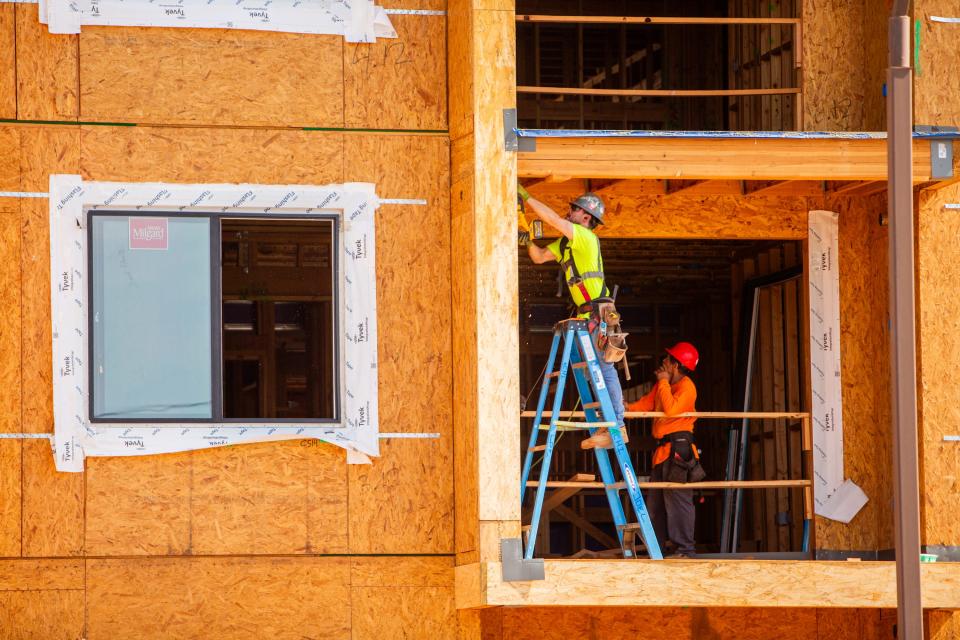
Greenwashing the building revolution?
The disparity in building code requirements across the Phoenix area is a reflection, experts say, of Arizona’s anti-regulation culture and lack of a statewide building code. When jurisdictions are left to adopt efficiency and sustainability measures one by one, progress can be hampered by conflicting motives. Some may pursue a greener visage while others ignore code upgrades out of disinterest, disorganization, a lack of resources or to compete for economic growth opportunities by keeping barriers low.
The result can be that cities and towns with more climate-friendly building codes build less, stunting the large-scale shifts scientists say are needed to meaningfully reduce urban heat and greenhouse gas emissions.
In 2019, Paradise Valley, Cave Creek and Carefree were named some of the least-affordable places in the region to buy a home, reflecting demand for more options. Each of these municipalities earned high climate scores of 4 for stricter development standards, making them low-impact locations to address the housing crisis. But each added fewer than 300 units between 2010 and 2020, according to an analysis of census data.
On the other end of the scale, The Republic’s building code review found that 82% of Maricopa County municipalities have not adopted the latest 2021 International Code Council standards, updated every three years. This includes the three fastest-growing, Phoenix, Mesa and Gilbert, which collectively added nearly 78,000 housing units between 2010 and 2020.
With climate and energy efficiency technology advancing quickly, each new version of standards encodes progress by leaps and bounds that can not only save money and energy, but also lives. A study published in July by the U.S. Department of Energy found that adopting 2021 International Energy Conservation Codes could reduce indoor heat deaths by as much as 80%.
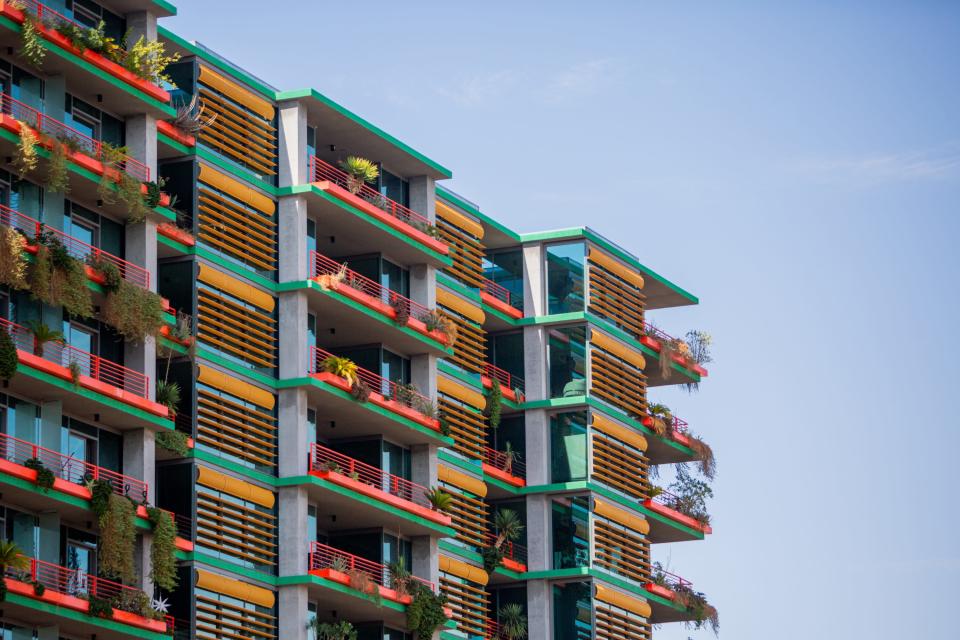
But adoption of updates is often blocked by special interest lobbies.
At a February 2022 meeting of the Scottsdale Building Advisory Board of Appeals, a representative from Southwest Gas opposed an electric readiness amendment that would have required builders to install wiring for electric appliances, potentially reducing demand for their fossil-fuel-based product. After those objections, the amendment was withdrawn. Southwest Gas told The Republic the company supports policies at all levels of government that give customers more energy choices.
“Developers, trade associations, business groups or other entities often have a vested interest in ensuring that the requirements are as minimal as possible,” said Caryn Potter, the Arizona representative for the Southwest Energy Efficiency Project, speaking more broadly. “They have the resources to ensure that they have someone they can send to every meeting and to be involved in every conversation.”
Potter worries that Arizona’s approach of upgrading building codes one city council meeting at a time results in progress being restricted to places where green measures are valued as a status symbol, rather than as an effective way to protect those most affected by rising urban heat and utility bills.
“The thing I’m concerned about is, are we using energy efficiency as a selling point to call these new buildings luxury homes and pricing out the people that need efficient homes the most?” she said. “More affluent communities, they can do this work themselves. But those on limited incomes, the working poor, renters, they can’t do these retrofits themselves and this is an important conversation for us to have.”
Where code updates are successful, these piecemeal gains can then be rendered relatively inert by conflicting policies that often align with sustainability values.
High-end communities have been known to adopt environmental regulations as a backhanded way to limit growth, for example, which experts say can raise the cost of living for existing residents and push affordable housing issues into neighboring areas. The practice is reminiscent of historically exclusionary zoning practices that upheld racial segregation in many parts of the country after the Civil Rights movement.
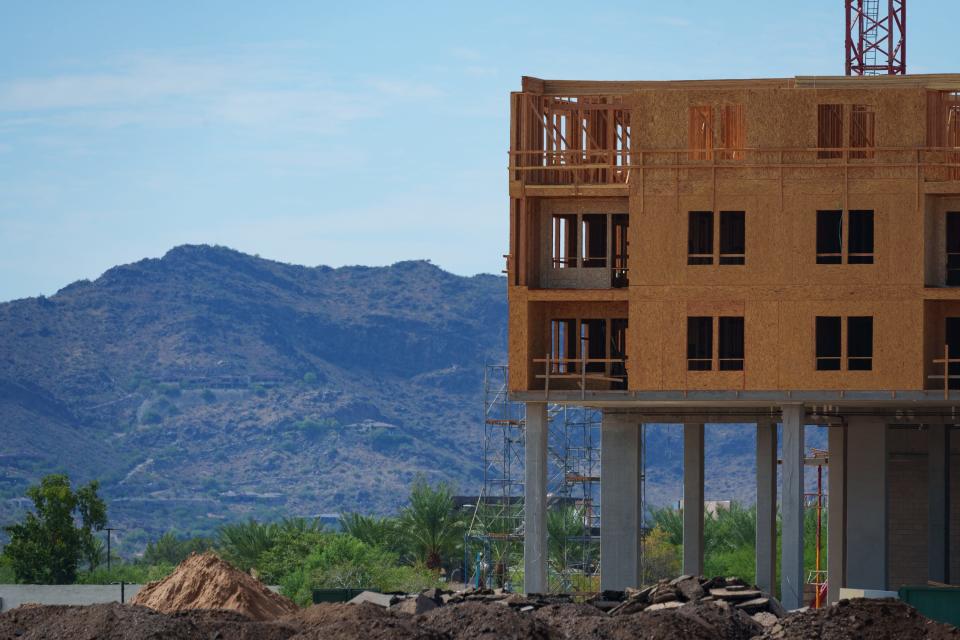
For developers and communities who are serious about sustainable development, green building certifications like LEED can showcase a commitment to climate-aware construction. But Dave Sailor, a professor of urban planning at ASU, hinted that this may just be a form of residential greenwashing. LEED certification “isn’t the end-all-be-all,” he said, and studies have shown it doesn’t necessarily equal drastic energy savings over other, newer ways of building.
“You could build the same building and just not pay to get it LEED-certified and it would save you $10,000 to $20,000, but you wouldn’t get that nice plaque,” Sailor said.
Scottsdale, where Southwest Gas shut down electric readiness, received widespread praise in 2022 for becoming one of the first in the nation, and the first in Arizona, to mandate the 2021 International Green Construction Code. For this, The Republic gave it a climate score of 5. But further reporting revealed this city's commitment to greener development to be highly controversial.
City Councilmember Solange Whitehead, who was a major force behind Scottsdale’s adoption of green standards and hopes the step may help other cities do the same, acknowledges that, as one of the wealthier areas in the state, the local measures had broad public support.
“We had the culture, we had the developers ready and willing, we had the skill on staff,” she said.
The standards still took three years to pass, with opposition coming from the Arizona Multihousing Association, which Whitehead described as a trade group for apartment developers that prioritizes immediate profits for their members.
That opposition letter was authored by Jake Hinman, a lobbyist for the association. In an interview, Hinman named Scottsdale as the Maricopa County city doing the least to address the housing crisis in a sustainable way.
Part of that is related to growth slowing in Scottsdale after Mayor David Ortega initiated changes to development standards in 2021 that stymied denser, multifamily housing projects with regulations on parking, building height, land use and zoning in favor of maintaining the city’s upscale, green aesthetic and classic “western vibe.”
Denser cities and more efficient land use are sure ways to address climate change and sustainability, experts say, while providing needed housing.
“But it’s the one thing that Scottsdale rejects,” Hinman said. “They don’t want density. So they adopt what I consider to be a symbolic gesture to say 'we’re a green city,' but then they don’t do the very thing that would help them curb emissions, conserve water, all of these things that we know building density and building on smaller lots does.”
Where the (political) rubber meets the (really hot) road
During the last legislative session, Hinman lobbied on behalf of two bills that sought to loosen city zoning to allow for denser, more sustainable housing development: Senate Bill 1117 and House Bill 2536.
The efforts won broad bipartisan support and the backing of diverse special interest groups such as the Greater Phoenix Chamber of Commerce, the Republican Liberty Caucus of Arizona, the Goldwater Institute, Arizona Coalition to End Sexual and Domestic Violence and Chispa, which advocates for Latino issues.
But both bills failed. Hinman attributes that to the lobbying efforts of Arizona cities and towns. Representatives from 17 Maricopa County cities showed up to oppose the bills, including nearly every city that received top scores in The Republic’s analysis of sustainability in building codes: Scottsdale (climate score of 5), Surprise (5), Buckeye (5), Phoenix (4), Mesa (4), Queen Creek (4), Paradise Valley (4), Peoria (4), Gilbert (4), El Mirage (4), as well as Tucson (5) and Prescott (5) outside of the metro area.
Nick Ponder, a public affairs consultant who represented opposition to HB 2536 on behalf of the League of Arizona Cities and Towns as well as Phoenix, Tucson, Paradise Valley and Yuma, said the League supports affordable housing development but felt that these bills were not the right approach.
“Cities have responsibilities beyond housing," Ponder said. "When we allow developments, we need to make sure they’re not in an area that is subject to a fissure or rainwater running down a mountain or too close to industrial properties, for example. The way these bills were written didn’t allow for these things to happen. We pointed this out, but sometimes developers want what they want and aren’t really considerate of other implications.”
Ponder says the league is supportive of legislation that would address housing issues, such as how short-term rentals take units off the market for residents, and has worked with lawmakers on related bills, only to have those efforts shut down.
But to many affordable housing advocates, Arizona cities showing up in force to oppose revising zoning is just the en-masse legislative version of locals protesting development in the name of “Not In My Backyard,” or NIMBY, attitudes.
“In my view, NIMBYism and these local (zoning) regulations have been an issue for a long time but in the last five to 10 years they’ve gotten really out of whack,” Hinman said. “It’s not just Arizona, it’s happening in every state. I think people would be surprised to know how powerful city lobbying is at the state capitol.”
What does it mean if nearly every city in Arizona that has adopted greener building standards then blocks zoning changes that would facilitate housing development in some of the most sustainable ways?
To Rep. Oscar De Los Santos, D-Phoenix, it means lawmakers are failing to lead on either climate or housing issues.
“Statewide and local land use laws make it difficult, if not outright illegal, to build housing that is affordable to everyday Arizonans,” De Los Santos told The Republic. “One of the major obstacles is that many members of the Republican majority simply do not believe that climate change is real, that it is caused by human activity, and that is an urgent problem. Consequently, the Republican majority takes no action to combat the climate crisis — including failing to invest in sustainable housing.”
The Republic, with support from MIT, also reviewed zoning documents for each Maricopa County municipality to gauge flexibility. The number and type of zoning districts vary widely, from nine in Tolleson and Youngtown to 47 in Scottsdale to 62 in Phoenix. These usually include multiple categories where undeveloped land is reserved exclusively for single-family homes. Gilbert has nine different single-family residential districts and three multifamily residential districts.
Rezoning can involve many time-consuming steps. In Chandler, for example, zoning amendments require the completion of an application from the zoning administrator and a citizen review process through which nearby landowners and “potentially affected citizens” are given 15 days’ notice by posters, mail and email of a neighborhood meeting and public hearing. If 20% of potentially affected landowners object, rezoning is denied unless 75% of the City Council overrides it.
Steve Kaiser, the former state senator who sponsored SB 1117 and other failed bills to loosen rezoning processes for affordable housing development, said Chandler has a particularly active “NIMBY” group, Voice of Chandler, that he said claims to have 50,000 members. They showed up at the state Capitol in 2022 to protest a proposal to rezone a plot behind a Target store that is designated for single-family housing to instead allow for 500 subsidized, high-density units. The group claimed the project would place a “severe burden” on infrastructure in Chandler, which has added more than 13,000 homes since 2010 but still only offers 13% of its housing as apartment-style units.
At a more local level, housing development is also subject to the whims of design standards set by neighborhood homeowners’ associations. Kaiser expressed frustration at the number of constraints HOAs put on development purely for the sake of aesthetics rather than for any practical reason. One outcome is limitations on adding duplexes and accessory dwelling units, like backyard “mother-in-law suites,” that could help ease the affordable housing crisis without expanding the urban footprint.
“They say it violates the ‘character’ of the neighborhood but basically what they’re saying in very polite terms is ‘we don’t want you here,’” Kaiser said. “It’s classic NIMBYism.”
Building the ‘character’ of a city
Kathy Shows and Fernando were absent from their sidewalk spot at 12th and Jefferson on subsequent nights in late July. It’s possible they landed one of Phoenix’s new shelter beds. The city added 592 beds in 2022 and has another 800 planned for 2023 and 2024. Toward the end of the July heat wave, it also opened a dozen transitional housing units made from shipping containers in the parking lot of the new, 200-bed St. Vincent de Paul shelter a few miles east of downtown.
Phoenix has enacted what many consider aggressive policies to address both homelessness and heat, with $140 million allocated to homeless solutions over the last two years and the first publicly-funded office for heat mitigation in the country (though this office's effectiveness has also been questioned). Local officials recognize the unique challenges faced by the nation's hottest and fastest-growing metro area, which haven't always been reflected in federal funding initiatives directed more at threats from the cold.
"Our building code in Phoenix needs to be different than the building code in Detroit, for example, because we are really building for a warmer climate," said Gallego, the Phoenix mayor. "Our challenges around energy efficiency tend to be more in the warmer months than the cooler months."
But meeting current housing needs will require that many processes accelerate, from subsidizing projects, to rezoning, to overcoming political and NIMBY objections, to sourcing materials and hiring enough workers to get the job done. And that’s without considering building sustainability or the urban heat island effect.
“We absolutely agree that working with planning and zoning committees on heat is absolutely important,” said Hondula, the heat office director. “But to be honest, that’s just not something we’ve been able to do yet.”
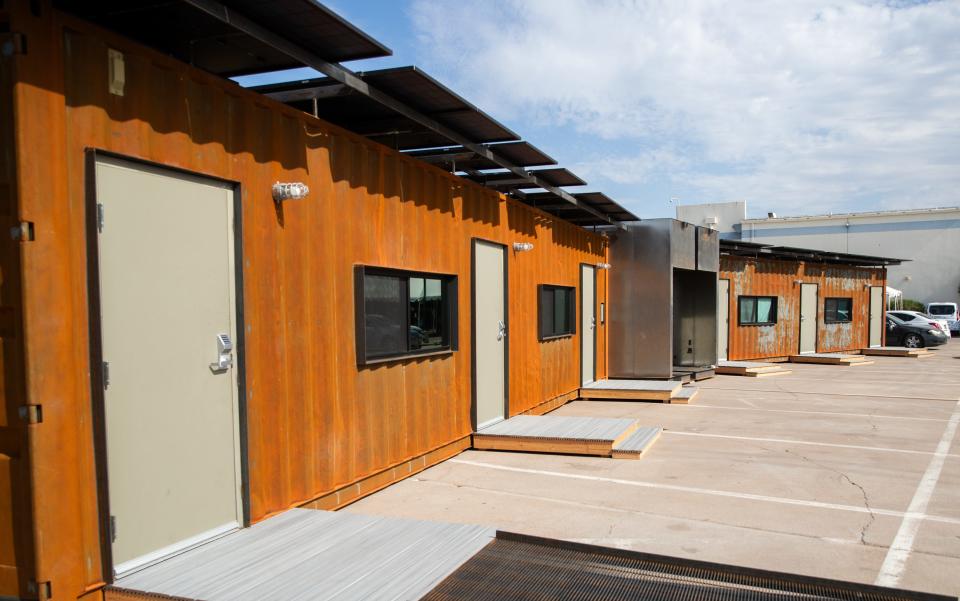
Meanwhile, local demand for shelter is rising alongside average temperatures.
Phillip Scarf is the chief operating officer at Central Arizona Shelter Services, which is part of a campus of services for unhoused people located in The Zone west of downtown. He said the organization is working on better ways to keep tabs on people, in part to understand the circumstances leading to outdoor heat deaths. But it’s challenging. Many don’t have phones or IDs. Climate change and urbanization are shifting where it's possible to survive.
“The impact that climate has on the transient population is huge,” Scharf said. “What we're seeing now is that places where they could be and have a good perspective of what they could anticipate are now no longer anticipatory spaces. From a heat standpoint, you have to provide services. But we can’t keep up with the need with what is being built.”
Kaiser, who resigned from the Legislature in June citing family reasons, would like to see more affordable housing development on vacant lots in downtown Phoenix and on agricultural land in outlying parts of the metro area.
“I think what’s really interesting is that the denser you go, the more sustainable it is from a water perspective and a power perspective,” Kaiser said. “When I think about Maricopa County, I think about all that agricultural land along the 101 in the West Valley. That’s using a ton of water and all of that should be multifamily housing. But you’d have to go through a rezoning process and you’d have people show up out of nowhere to oppose the project.”
De Los Santos will continue the rezoning fight in the Legislature to pave the way for more sustainable housing. He also wants to help set Arizona on a better clean energy path by addressing how he says utilities have enacted barriers to rooftop solar that all but remove financial incentives for homeowners to produce their own energy. Multiple power outages across the metro area this summer lent urgency to concerns over how to manage a loss of air conditioning in hot conditions.
He is encouraged by a recent federal initiative to help repurpose commercial properties as affordable residential units, which he said presents an opportunity to create housing with reduced energy costs and emissions compared with new construction. One such project is already underway in Phoenix, with plans to turn parts of the shuttered Metrocenter, once the Southwest’s largest indoor mall, into more than 2,600 apartment units.
There are many avenues toward a more sustainable Phoenix, he said, such as creating incentives for green building practices, reforming zoning and groundwater management practices, expanding programs like cool roofs and cool pavement and pursuing federal funding for energy efficiency upgrades.
But Arizona’s first priority, De Los Santos said, should be ending the homelessness disaster, so that no one has to sweat through the night on a sidewalk downtown in the middle of a historic heat wave.
“In the wealthiest society in human history, it is nothing short of immoral to have thousands of human beings out on the streets exposed to deadly heat waves.”
Julia Arin Cooper contributed to this report.
This story is part of a series by The Republic on the intersection of the housing and climate crises that has been supported by an MIT Environmental Solutions Journalism Fellowship.
Joan Meiners is the climate news and storytelling reporter at The Republic and azcentral.com. Before becoming a journalist, she completed a doctorate in ecology. Follow Joan on Twitter at @beecycles or email her at joan.meiners@arizonarepublic.com. Read more of her coverage at environment.azcentral.com.
Subscribe to AZ Climate, The Republic's weekly environment and climate newsletter. Sign up here.
Support climate coverage and local journalism by subscribing to azcentral.com at this link.
This article originally appeared on Arizona Republic: Can new building codes save metro Phoenix from heat, housing crises?

